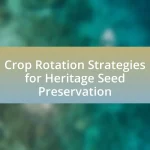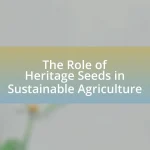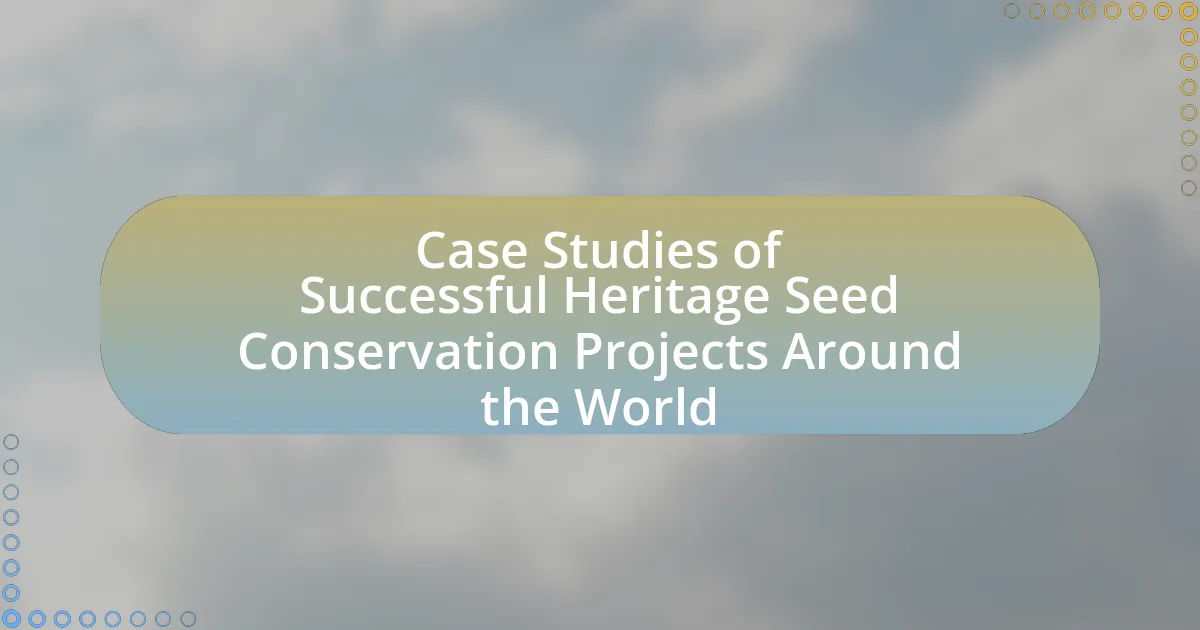The article focuses on policy recommendations for supporting heritage seeds as a vital component of biodiversity conservation efforts. It outlines the importance of heritage seeds in preserving genetic diversity, enhancing ecosystem resilience, and contributing to agricultural diversity. Key strategies discussed include establishing legal frameworks, promoting community seed banks, and providing financial incentives for farmers to cultivate heritage seeds. The article also addresses the challenges faced by heritage seeds, such as genetic erosion and market pressures, while emphasizing the role of stakeholders, including local farmers and NGOs, in effective policy implementation and conservation initiatives.

What are Policy Recommendations for Supporting Heritage Seeds in Biodiversity Conservation Efforts?
Policy recommendations for supporting heritage seeds in biodiversity conservation efforts include establishing legal frameworks that protect traditional seed varieties, promoting community seed banks, and incentivizing farmers to cultivate and share heritage seeds. Legal frameworks, such as the International Treaty on Plant Genetic Resources for Food and Agriculture, safeguard the rights of farmers and ensure access to diverse seed varieties. Community seed banks serve as repositories for local heritage seeds, preserving genetic diversity and enabling farmers to access seeds adapted to local conditions. Additionally, financial incentives, such as subsidies or grants for farmers who grow heritage seeds, encourage the cultivation of these varieties, thereby enhancing biodiversity and resilience in agricultural systems.
Why are heritage seeds important for biodiversity conservation?
Heritage seeds are crucial for biodiversity conservation because they preserve genetic diversity within plant species. This genetic diversity is essential for ecosystem resilience, allowing plants to adapt to changing environmental conditions and resist pests and diseases. According to the Food and Agriculture Organization, over 75% of crop diversity has been lost since the 1900s, highlighting the importance of heritage seeds in maintaining agricultural biodiversity. By cultivating and protecting these seeds, we ensure the survival of diverse plant varieties that contribute to food security and ecological balance.
What role do heritage seeds play in ecosystem resilience?
Heritage seeds play a crucial role in ecosystem resilience by preserving genetic diversity, which enhances the adaptability of plant species to changing environmental conditions. This genetic variability allows crops to withstand pests, diseases, and climate fluctuations, thereby maintaining agricultural productivity and ecosystem stability. Research indicates that diverse seed varieties can improve soil health and promote beneficial interactions among species, contributing to overall ecosystem functionality. For instance, a study published in the journal “Agriculture, Ecosystems & Environment” highlights that heritage seeds can increase resilience against drought and other stressors, demonstrating their importance in sustainable agriculture and biodiversity conservation efforts.
How do heritage seeds contribute to agricultural diversity?
Heritage seeds contribute to agricultural diversity by preserving a wide range of genetic traits that are essential for adapting to changing environmental conditions. These seeds, often heirloom varieties, have been cultivated over generations and exhibit unique characteristics such as drought resistance, pest tolerance, and flavor profiles that are not found in modern hybrids. Research indicates that heritage seeds can enhance ecosystem resilience, as they provide a genetic reservoir that supports biodiversity and helps maintain soil health. For instance, a study published in the journal “Agricultural Systems” highlights that diverse crop varieties, including heritage seeds, can improve yield stability and reduce the risk of crop failure due to climate variability.
What challenges do heritage seeds face in conservation efforts?
Heritage seeds face significant challenges in conservation efforts, primarily due to genetic erosion, loss of traditional farming practices, and market pressures favoring hybrid seeds. Genetic erosion occurs when diverse seed varieties are not cultivated, leading to a decline in genetic diversity, which is crucial for resilience against pests and climate change. The loss of traditional farming practices, often linked to industrial agriculture, diminishes the cultivation of heritage seeds, as farmers increasingly adopt high-yield hybrid varieties that are easier to manage but less diverse. Additionally, market pressures create economic disincentives for farmers to grow heritage seeds, as they may not be as profitable compared to commercially available hybrids. These factors collectively threaten the sustainability and availability of heritage seeds, undermining biodiversity conservation efforts.
How does modern agriculture impact heritage seed varieties?
Modern agriculture significantly threatens heritage seed varieties through practices such as monoculture, hybridization, and the use of genetically modified organisms (GMOs). These practices reduce genetic diversity by favoring high-yield, uniform crops over traditional varieties, which often possess unique traits adapted to local environments. For instance, a study published in the journal “Nature” highlights that the global area planted with heritage varieties has decreased by over 75% in the last century due to industrial farming methods. This loss of biodiversity not only endangers the resilience of food systems but also diminishes the cultural heritage associated with traditional farming practices.
What are the economic barriers to preserving heritage seeds?
The economic barriers to preserving heritage seeds include high costs of seed production, limited market demand, and competition from hybrid and genetically modified seeds. High production costs arise from the labor-intensive methods required for maintaining heritage varieties, which often lack the economies of scale enjoyed by commercial seed producers. Limited market demand results from consumer preferences for uniformity and higher yields associated with modern seed varieties, leading to reduced financial incentives for farmers to cultivate heritage seeds. Additionally, competition from hybrid and genetically modified seeds, which are often subsidized and marketed aggressively, further diminishes the viability of heritage seeds in the agricultural market. These factors collectively hinder the economic sustainability of heritage seed preservation efforts.
What key policies can support heritage seeds in biodiversity conservation?
Key policies that can support heritage seeds in biodiversity conservation include the establishment of legal frameworks that protect traditional agricultural practices and the promotion of seed sovereignty. Legal frameworks, such as the International Treaty on Plant Genetic Resources for Food and Agriculture, provide guidelines for the conservation and sustainable use of genetic resources, ensuring that heritage seeds are preserved. Additionally, promoting seed sovereignty empowers local communities to maintain control over their seed varieties, fostering biodiversity and resilience in agricultural systems. These policies are essential for safeguarding the genetic diversity that heritage seeds represent, which is crucial for food security and ecosystem health.
How can governments incentivize the use of heritage seeds?
Governments can incentivize the use of heritage seeds by implementing financial subsidies and grants for farmers who cultivate these seeds. Such financial support encourages farmers to choose heritage varieties over commercial hybrids, which often dominate the market. For instance, programs like the USDA’s Conservation Stewardship Program have successfully promoted biodiversity by providing payments to farmers who adopt sustainable practices, including the use of heritage seeds. Additionally, governments can establish tax breaks for businesses that sell or promote heritage seeds, further stimulating market demand. Research indicates that regions with supportive policies for heritage seeds see increased agricultural diversity and resilience, highlighting the effectiveness of these incentives.
What role do community seed banks play in policy frameworks?
Community seed banks play a crucial role in policy frameworks by promoting biodiversity conservation and supporting local agricultural practices. They serve as repositories for heritage seeds, ensuring the preservation of genetic diversity essential for food security and resilience against climate change. Policies that incorporate community seed banks can enhance local governance, empower farmers, and facilitate access to diverse seed varieties, which is vital for sustainable agriculture. Evidence from various studies indicates that integrating community seed banks into national and regional policies can lead to improved agricultural productivity and ecological stability, as seen in initiatives across countries like India and Brazil, where such frameworks have successfully supported local farming communities.

How can stakeholders collaborate to enhance heritage seed conservation?
Stakeholders can collaborate to enhance heritage seed conservation by forming partnerships that integrate local farmers, agricultural organizations, and governmental bodies to share knowledge and resources. Collaborative efforts can include establishing community seed banks, which have been shown to preserve genetic diversity and promote sustainable agricultural practices. For instance, the Seed Savers Exchange, a nonprofit organization, has successfully facilitated the sharing of heirloom seeds among gardeners and farmers, demonstrating the effectiveness of community-driven initiatives in conserving heritage seeds. Additionally, stakeholders can engage in joint research projects to document and promote the benefits of heritage seeds, thereby raising awareness and encouraging their use in local farming systems.
What partnerships are essential for effective heritage seed policies?
Effective heritage seed policies require partnerships among farmers, governmental agencies, non-governmental organizations (NGOs), and academic institutions. Farmers provide traditional knowledge and practical experience, while governmental agencies create regulatory frameworks that support seed conservation. NGOs often facilitate community engagement and advocacy for heritage seeds, and academic institutions contribute research and innovation to improve seed varieties and farming practices. These collaborations enhance the effectiveness of heritage seed policies by integrating diverse expertise and resources, ultimately promoting biodiversity conservation.
How can NGOs contribute to heritage seed conservation efforts?
NGOs can contribute to heritage seed conservation efforts by implementing community-based seed banks that preserve local seed varieties. These organizations often engage local farmers in the collection, storage, and sharing of heritage seeds, ensuring genetic diversity and resilience against climate change. For instance, the Seed Savers Exchange, a prominent NGO, has successfully facilitated the preservation of over 25,000 heirloom seed varieties, demonstrating the effectiveness of grassroots initiatives in maintaining biodiversity. Additionally, NGOs can provide education and resources to farmers about sustainable agricultural practices, further enhancing the conservation of heritage seeds.
What is the role of local farmers in policy implementation?
Local farmers play a crucial role in policy implementation by acting as key stakeholders who provide practical insights and feedback on agricultural policies. Their firsthand experience with heritage seeds and biodiversity conservation allows them to inform policymakers about the challenges and opportunities in sustainable farming practices. For instance, local farmers can contribute to the development of policies that promote the use of heritage seeds, which are vital for maintaining genetic diversity and resilience in crops. Studies have shown that involving farmers in policy discussions leads to more effective and relevant agricultural strategies, as their knowledge directly impacts the success of conservation efforts.
How can education and awareness improve heritage seed conservation?
Education and awareness can significantly improve heritage seed conservation by fostering a deeper understanding of the importance of biodiversity and traditional agricultural practices. When individuals are educated about the ecological, cultural, and nutritional value of heritage seeds, they are more likely to engage in conservation efforts. For instance, studies have shown that communities with educational programs on sustainable agriculture and seed saving practices have increased their participation in heritage seed conservation initiatives. This is evidenced by the success of programs like Seed Savers Exchange, which has documented over 25,000 varieties of heirloom seeds, emphasizing the role of community education in preserving genetic diversity. By raising awareness, stakeholders can mobilize support for policies that protect heritage seeds, ensuring their preservation for future generations.
What educational programs can promote the value of heritage seeds?
Educational programs that can promote the value of heritage seeds include community workshops, school curricula focused on agriculture and biodiversity, and online courses about sustainable farming practices. Community workshops can engage local farmers and gardeners, providing hands-on experiences with heritage seeds, which fosters appreciation and understanding of their importance in biodiversity. School curricula can incorporate lessons on the history and benefits of heritage seeds, helping students recognize their role in food security and ecological balance. Online courses can reach a broader audience, offering information on seed saving techniques and the ecological significance of preserving genetic diversity in crops. These educational initiatives are supported by research indicating that increased awareness and knowledge about heritage seeds can lead to greater conservation efforts and sustainable agricultural practices.
How can public awareness campaigns influence policy change?
Public awareness campaigns can significantly influence policy change by mobilizing public opinion and increasing visibility on specific issues. When campaigns effectively educate the public about the importance of heritage seeds in biodiversity conservation, they can create a groundswell of support that policymakers cannot ignore. For instance, campaigns that highlight the ecological benefits of heritage seeds, such as their role in maintaining genetic diversity and resilience in agriculture, can lead to increased public demand for policies that protect these seeds. Research has shown that public engagement through awareness campaigns can lead to legislative action; for example, the successful campaign for the protection of heirloom varieties in various countries has resulted in the establishment of supportive agricultural policies.

What are the best practices for implementing heritage seed policies?
The best practices for implementing heritage seed policies include establishing legal frameworks that protect heritage seeds, promoting community involvement in seed conservation, and ensuring access to these seeds for farmers. Legal frameworks, such as intellectual property rights that favor traditional knowledge, help safeguard heritage seeds from commercial exploitation. Community involvement fosters local stewardship and knowledge sharing, which are crucial for maintaining seed diversity. Additionally, providing farmers with access to heritage seeds through subsidies or seed banks encourages the cultivation of these varieties, thereby enhancing agricultural biodiversity. These practices are supported by studies indicating that legal protections and community engagement significantly contribute to the sustainability of heritage seed systems.
What strategies can ensure the sustainability of heritage seed programs?
To ensure the sustainability of heritage seed programs, implementing community engagement, education, and legal protection strategies is essential. Community engagement fosters local ownership and participation, which can enhance the preservation of heritage seeds. Education initiatives raise awareness about the importance of biodiversity and traditional agricultural practices, encouraging more farmers to adopt heritage seeds. Legal protection, such as intellectual property rights for traditional knowledge, safeguards against biopiracy and promotes the use of heritage seeds in sustainable agriculture. These strategies are supported by evidence showing that community-led initiatives and educational programs have successfully increased the adoption and preservation of heritage seeds in various regions, thereby contributing to biodiversity conservation efforts.
How can monitoring and evaluation improve policy effectiveness?
Monitoring and evaluation enhance policy effectiveness by providing data-driven insights that inform decision-making and improve implementation strategies. By systematically assessing the outcomes of policies related to heritage seeds, stakeholders can identify successful practices and areas needing adjustment. For instance, a study by the World Bank found that effective monitoring frameworks can lead to a 20% increase in project success rates by enabling timely interventions based on real-time data. This continuous feedback loop ensures that policies remain relevant and responsive to changing environmental conditions and community needs, ultimately fostering better conservation outcomes.
What role does research play in developing heritage seed policies?
Research plays a critical role in developing heritage seed policies by providing evidence-based insights that inform decision-making and policy formulation. It identifies the genetic diversity of heritage seeds, assesses their ecological significance, and evaluates the socio-economic benefits of preserving these seeds. For instance, studies have shown that heritage seeds contribute to agricultural resilience and food security, as evidenced by the work of the Food and Agriculture Organization, which highlights the importance of genetic diversity in adapting to climate change. Additionally, research helps in understanding the cultural value of heritage seeds, ensuring that policies reflect the needs and practices of local communities. This comprehensive understanding enables policymakers to create effective frameworks that support the conservation and sustainable use of heritage seeds.
What practical steps can individuals take to support heritage seeds?
Individuals can support heritage seeds by cultivating them in home gardens, which helps preserve genetic diversity. By growing heritage varieties, individuals contribute to the maintenance of these seeds and their unique traits, which are often adapted to local conditions. Additionally, individuals can participate in seed-saving initiatives, where they collect and store seeds from their plants to ensure their availability for future planting. Engaging with local seed banks or community-supported agriculture programs also aids in the distribution and promotion of heritage seeds. Furthermore, educating others about the importance of heritage seeds and advocating for policies that protect them can amplify their impact on biodiversity conservation.
How can home gardeners contribute to heritage seed preservation?
Home gardeners can contribute to heritage seed preservation by cultivating and saving seeds from heirloom varieties. This practice helps maintain genetic diversity and ensures the survival of traditional crops that may be at risk of extinction. According to the Seed Savers Exchange, a nonprofit organization dedicated to preserving heirloom seeds, home gardeners play a crucial role in maintaining the genetic integrity of these varieties by sharing seeds within their communities, thus promoting biodiversity. By participating in seed-saving initiatives and educating others about the importance of heritage seeds, home gardeners actively support conservation efforts and contribute to sustainable agriculture.
What resources are available for individuals interested in heritage seeds?
Individuals interested in heritage seeds can access a variety of resources, including seed banks, online databases, and educational programs. Seed banks, such as the Seed Savers Exchange, preserve and distribute heritage seeds, allowing individuals to obtain diverse varieties. Online databases like the USDA’s National Plant Germplasm System provide information on seed availability and conservation efforts. Additionally, educational programs offered by organizations like the Slow Food Movement teach individuals about the importance of heritage seeds and how to cultivate them, promoting biodiversity and sustainable agriculture.





